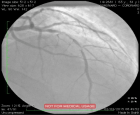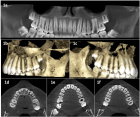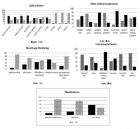Abstract
Case Report
Short and Medium-Term Evaluation of Patients in Coronary Post-Angioplasty: Préliminary results at the Cardiology Department of the Hospital University Aristide Le Dantec of Dakar (Senegal): Study on 38 Cases
Dioum M*, Aw F, Masmoudi K, Gaye ND, Sarr SA, Ndao SCT, Mingou J, Ngaidé AA, Diack B, Bodian M, Ndiaye MB, Diao M and Ba SA
Published: 20 February, 2017 | Volume 2 - Issue 1 | Pages: 008-012
Introduction: Coronary angioplasty is a safe therapeutic method for coronary disease. However, its major obstacles remain the occurrence of stent thrombosis (ST) and in-stent restenosis (ISR). The aim of this study was to evaluate the short-term and medium-term results of coronary angioplasty patients in the cardiology department of Aristide Le Dantec hospital in Dakar.
Methodology: It was a longitudinal, descriptive and analytical study over a period of 12 months (April 2014 to April 2015) with a follow-up at 6 months. Was included any patient who had a coronary angioplasty with stent placement.
Results: Thirty-eight patients had been included with a male predominance and a sex ratio of 5.32. The average age was 57.94 years. Cardiovascular risk factors were mainly smoking (57.9%) and coronary heredity (42.1%), followed by hypertension (39.5%) and diabete (34.2%). The indications for angioplasty were acute coronary syndromes TS(+) and TS(-) respectively (50%) and (23.7%) and stable angina (26.3%). The right femoral approach was almost exclusive (97.4%). Coronary angiography revealed a predominance of anterior interventricular affection (84.2%). Type B lesions were the most frequent (68.4%). The single-truncal valve affection was predominant (76.3%). Direct stenting accounted for 63.2% of procedures. Twenty-one bare stents (55.3%) and 17 active stents (44.7%) were implanted. The results were excellent (94.7%). One case of acute stent thrombosis was noted. Echocardiography of dobutamine stress during follow-up was positive in 04 patients (12.5%). The control coronary angiography performed in two patients revealed an ISR. The predictive factors for restenosis were dominated by a deterioration in the segmental kinetics (p=0.009), in the diastolic function (p=0.002), the systolic function (p=0.003), a high post angioplasty troponin (p=0.004), the presence of calcifications (p=0.004) and a high SYNTAX score (p=0.021).
Conclusion: According to these results, Angioplasty is an effective therapy for coronary disease. However, a correct intake of double platelet antiaggregants and clinical and non-invasive screening are required for follow-up to avoid stent thrombosis or restenosis.
Read Full Article HTML DOI: 10.29328/journal.jccm.1001006 Cite this Article Read Full Article PDF
References
- The top 10 causes of death. 2013; Cité 30. Disponible sur: Ref.: https://goo.gl/bLfjF2
- Maboury Diao, Serigne Abdou B. Maladies cardio-vasculaires et complications. CHU le Dantecm, Dakar-Sénégal 2013. Ref.: https://goo.gl/KgXNvJ
- Philippe F, Dibie A, Larrazet F, Meziane T, Folliguet T et al. Les stents à élution de médicaments: preuves, incertitudes et pratiques. Ann Cardiol Angéiol. 2005; 54: 201-211. Ref.: https://goo.gl/ascnp5
- Chevalier B, Blanchard D, Berland J, Carrié D, Gilard M et al. Endoprothèses actives: Indications, limites et développements. Arch Mal Coeur Vaiss. 2005; 98: 1013-1021. Ref.: https://goo.gl/CuHW2l
- Bauters C, Hubert E, Prat A, Bougrimi K, Van Belle EA, et al. Predictors of restenosis after coronary stent implantation. J Am Coll Cardiol. 1998; 31: 1291-1298. Ref.: https://goo.gl/smViit
- Serruys PW, Kay IP, Disco C, Deshpande NV, de Feyter PJ. Periprocedural quantitative coronary angiography after Palmaz-Schatz stent implantation predicts the restenosis rate at six months: results of a meta-analysis of the BElgian NEtherlands Stent study (BENESTENT) I, BENESTENT II Pilot, BENESTENT II and MUSIC trials. Multicenter Ultrasound Stent In Coronaries. J Am Coll Cardiol. 1999; 34: 1067-1074. Ref.: https://goo.gl/8YghtL
- Schiele F. Predictive factors of restenosis: what changes with "active" stents? Pathology Biology. 2004; 52: 206-211. Ref.: https://goo.gl/RAkuK4
- Zouaoui W, Ouldzein H, Boudou N, Dumonteil N, Bongard V, et al. Factors predictive for in-hospital mortality following percutaneous coronary intervention. Arch Cardiovasc Dis. 2008; 101: 443-448. Ref.: https://goo.gl/MxVZQH
- Wilensky RL, Selzer F, Johnston J, Laskey WK, Klugherz BD, et al. Relation of percutaneous coronary intervention of complex lesions to clinical outcomes (from the NHLBI Dynamic Registry). Am J Cardiol. 2002; 90: 216-221. Ref.: https://goo.gl/XDUHkh
- Assali AR, Moustapha A, Sdringola S, Salloum J, Awadalla H et al. The dilemma of success: percutaneous coronary interventions in patients > or = 75 years of age-successful but associated with higher vascular complications and cardiac mortality. Catheter Cardiovasc Interv. 2003; 59: 195-199. Ref.: https://goo.gl/3wtkA1
- Cambou JP, Simon T, Mulak G, Bataille V, Danchin N. The French Registry of Acute ST Elevation or Non-ST-Elevation Myocardial Infarction (FAST-MI): study design and baseline characteristics. Arch Mal Coeur Vaiss. 2007; 100: 524-534. Ref.: https://goo.gl/yHc6nN
- Ko DT, Atzema CL, Donovan LR, Graham MM, Huynh T. Rescue Percutaneous Coronary Interventions for Failed Fibrinolytic Therapy in ST-segment Elevation Myocardial Infarction. Am Heart J. 2011; 161: 764-770. Ref.: https://goo.gl/46D3YW
- Authors/Task Force members, Windecker S, Kolh P, Alfonso F, Collet JP, et al. 2014 ESC/EACTS Guidelines on myocardial revascularization: The Task Force on myocardial revascularization of the European Society of Cardiology (ESC), the European Association for Cardio-Thoracic Surgery (EACTS), European Association for Percutaneous Cardiovascular Interventions (EAPCI). Eur Heart J. 2010; 31: 2541-2619. Ref.: https://goo.gl/tfUL2t
- Chevalier B. American recommendations on coronary angioplasty. Consensus Cardio. 2012; 78: 1-4.
- Serruys PW, de Jaegere P, Kiemeneij F, Macaya C, Rutsch W, et al. A comparison of balloon-expandable-stent implantation with balloon angioplasty in patients with coronary artery disease. Benestent Study Group. N Eng J Med. 1994; 331: 489-495. Ref.: https://goo.gl/Mk8PT0
- Serruys PW, van Hout B, Bonnier H, Legrand V, Garcia E, et al. Randomised comparison of implantation of heparin-coated stents with balloon angioplasty in selected patients with coronary artery disease (BENESTENT II). Lancet. 1998; 352: 673-681. Ref.: https://goo.gl/fWcRre
- Cutlip DE, Chauhan MS, Baim DS, Ho KK, Popma JJ, et al. Clinical Restenosis After Coronary Stenting: Perspectives From Multicenter Clinical Trials. J Am Coll Cardiol. 2002; 40: 2082-2089. Ref.: https://goo.gl/aOD490
Figures:

Figure 1
Similar Articles
-
Left Atrial Remodeling is Associated with Left Ventricular Remodeling in Patients with Reperfused Acute Myocardial InfarctionChristodoulos E. Papadopoulos*,Dimitrios G. Zioutas,Panagiotis Charalambidis,Aristi Boulbou,Konstantinos Triantafyllou,Konstantinos Baltoumas,Haralambos I. Karvounis,Vassilios Vassilikos. Left Atrial Remodeling is Associated with Left Ventricular Remodeling in Patients with Reperfused Acute Myocardial Infarction. . 2016 doi: 10.29328/journal.jccm.1001001; 1: 001-008
-
Mid-Ventricular Ballooning in Atherosclerotic and Non-Atherosclerotic Abnormalities of the Left Anterior Descending Coronary ArteryStefan Peters*. Mid-Ventricular Ballooning in Atherosclerotic and Non-Atherosclerotic Abnormalities of the Left Anterior Descending Coronary Artery. . 2016 doi: 10.29328/journal.jccm.1001002; 1:
-
Concentration Polarization of Ox-LDL and Its Effect on Cell Proliferation and Apoptosis in Human Endothelial CellsShijie Liu*,Jawahar L Mehta,Yubo Fan,Xiaoyan Deng,Zufeng Ding*. Concentration Polarization of Ox-LDL and Its Effect on Cell Proliferation and Apoptosis in Human Endothelial Cells. . 2016 doi: 10.29328/journal.jccm.1001003; 1:
-
Intermittent Left Bundle Branch Block: What is the Mechanism?Hussam Ali*,Riccardo Cappato. Intermittent Left Bundle Branch Block: What is the Mechanism?. . 2017 doi: 10.29328/journal.jccm.1001004; 2:
-
Congenital Quadricuspid Aortic Valve, a Rare Cause of Aortic Insufficiency in Adults: Case ReportCyrus Kocherla*,Kalgi Modi. Congenital Quadricuspid Aortic Valve, a Rare Cause of Aortic Insufficiency in Adults: Case Report. . 2017 doi: 10.29328/journal.jccm.1001005; 2: 003-007
-
Short and Medium-Term Evaluation of Patients in Coronary Post-Angioplasty: Préliminary results at the Cardiology Department of the Hospital University Aristide Le Dantec of Dakar (Senegal): Study on 38 CasesDioum M*,Aw F,Masmoudi K,Gaye ND,Sarr SA,Ndao SCT, Mingou J,Ngaidé AA,Diack B,Bodian M,Ndiaye MB,Diao M,Ba SA. Short and Medium-Term Evaluation of Patients in Coronary Post-Angioplasty: Préliminary results at the Cardiology Department of the Hospital University Aristide Le Dantec of Dakar (Senegal): Study on 38 Cases. . 2017 doi: 10.29328/journal.jccm.1001006; 2: 008-012
-
Indications and Results of Coronarography in Senegalese Diabetic Patients: About 45 CasesNdao SCT*,Gaye ND,Dioum M,Ngaide AA,Mingou JS,Ndiaye MB, Diao M,Ba SA. Indications and Results of Coronarography in Senegalese Diabetic Patients: About 45 Cases. . 2017 doi: 10.29328/journal.jccm.1001007; 2: 013-019
-
Procedure utilization, latency and mortality: Weekend versus Weekday admission for Myocardial InfarctionNader Makki,David M Kline,Arun Kanmanthareddy,Hansie Mathelier,Satya Shreenivas,Scott M Lilly*. Procedure utilization, latency and mortality: Weekend versus Weekday admission for Myocardial Infarction. . 2017 doi: 10.29328/journal.jccm.1001008; 2: 020-025
-
Spontaneous rupture of a giant Coronary Artery Aneurysm after acute Myocardial InfarctionOğuzhan Çelik,Mucahit Yetim,Tolga Doğan,Lütfü Bekar,Macit Kalçık*,Yusuf Karavelioğlu. Spontaneous rupture of a giant Coronary Artery Aneurysm after acute Myocardial Infarction. . 2017 doi: 10.29328/journal.jccm.1001009; 2: 026-028
-
Thrombolysis, the only Optimally Rapid Reperfusion TreatmentVictor Gurewich*. Thrombolysis, the only Optimally Rapid Reperfusion Treatment. . 2017 doi: 10.29328/journal.jccm.1001010; 2: 029-034
Recently Viewed
-
Comparative Studies of Diclofenac Sodium (NSAID) Adsorption on Wheat (Triticum aestivum) Bran and Groundnut (Arachis hypogaea) Shell Powder using Vertical and Sequential Bed ColumnNeha Dhiman*. Comparative Studies of Diclofenac Sodium (NSAID) Adsorption on Wheat (Triticum aestivum) Bran and Groundnut (Arachis hypogaea) Shell Powder using Vertical and Sequential Bed Column. Ann Adv Chem. 2024: doi: 10.29328/journal.aac.1001052; 8: 021-029
-
Simple Modified Transvesical Prostatectomy with Minimum Incision and Endoscopic Vascular Control: A Case ReportAntônio Carlos Oliveira Almeida*,Anuar Ibrahim Mitre,Elcio Dias Silva*. Simple Modified Transvesical Prostatectomy with Minimum Incision and Endoscopic Vascular Control: A Case Report. Arch Case Rep. 2025: doi: 10.29328/journal.acr.1001119; 9: 001-003
-
Localization of the occluded vessel in acute myocardial infarctionSamir Rafla*,Amr Kamal. Localization of the occluded vessel in acute myocardial infarction. J Cardiol Cardiovasc Med. 2020: doi: 10.29328/journal.jccm.1001082; 5: 029-033
-
Acyclovir Induced Acute Kidney Injury: A Case ReportZiauddin Mohammed*, Mariya Zoha Muskan, Megha Mohan Narayanan. Acyclovir Induced Acute Kidney Injury: A Case Report. Arch Pharm Pharma Sci. 2024: doi: 10.29328/journal.apps.1001048; 8: 001-002
-
Evaluation of the Anti-inflammatory Activity of Equisetum arvense and Baccharis trimera FractionsCarolina Ferreira Vaz, Alan Fernandes Mariano, Júlia Amanda Rodrigues Fracasso, Marcus Vinicius Vieitas Ramos, Lucineia dos Santos, Herbert Júnior Dias*. Evaluation of the Anti-inflammatory Activity of Equisetum arvense and Baccharis trimera Fractions. Arch Pharm Pharma Sci. 2024: doi: 10.29328/journal.apps.1001049; 8: 003-008
Most Viewed
-
Evaluation of Biostimulants Based on Recovered Protein Hydrolysates from Animal By-products as Plant Growth EnhancersH Pérez-Aguilar*, M Lacruz-Asaro, F Arán-Ais. Evaluation of Biostimulants Based on Recovered Protein Hydrolysates from Animal By-products as Plant Growth Enhancers. J Plant Sci Phytopathol. 2023 doi: 10.29328/journal.jpsp.1001104; 7: 042-047
-
Sinonasal Myxoma Extending into the Orbit in a 4-Year Old: A Case PresentationJulian A Purrinos*, Ramzi Younis. Sinonasal Myxoma Extending into the Orbit in a 4-Year Old: A Case Presentation. Arch Case Rep. 2024 doi: 10.29328/journal.acr.1001099; 8: 075-077
-
Feasibility study of magnetic sensing for detecting single-neuron action potentialsDenis Tonini,Kai Wu,Renata Saha,Jian-Ping Wang*. Feasibility study of magnetic sensing for detecting single-neuron action potentials. Ann Biomed Sci Eng. 2022 doi: 10.29328/journal.abse.1001018; 6: 019-029
-
Pediatric Dysgerminoma: Unveiling a Rare Ovarian TumorFaten Limaiem*, Khalil Saffar, Ahmed Halouani. Pediatric Dysgerminoma: Unveiling a Rare Ovarian Tumor. Arch Case Rep. 2024 doi: 10.29328/journal.acr.1001087; 8: 010-013
-
Physical activity can change the physiological and psychological circumstances during COVID-19 pandemic: A narrative reviewKhashayar Maroufi*. Physical activity can change the physiological and psychological circumstances during COVID-19 pandemic: A narrative review. J Sports Med Ther. 2021 doi: 10.29328/journal.jsmt.1001051; 6: 001-007

HSPI: We're glad you're here. Please click "create a new Query" if you are a new visitor to our website and need further information from us.
If you are already a member of our network and need to keep track of any developments regarding a question you have already submitted, click "take me to my Query."
























































































































































